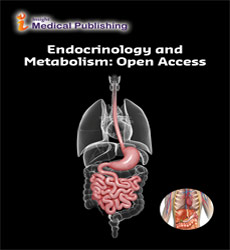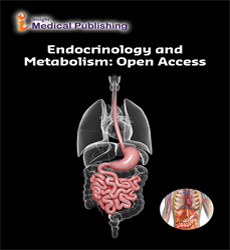A Transitory on Intracellular Receptors
Saukko Siegel*
Department of Forensic Medicine, University of Turku, Turku, Finland
- *Corresponding Author:
- Saukko Siegel
Department of Forensic Medicine
University of Turku
Turku, Finland
E-mail: ssaukko15@gmail.com
Received Date: July 05, 2021; Accepted Date: July 19, 2021; Published Date: July 26, 2021
Citation: Siegel S (2021) A Transitory on Intracellular Receptors. Endocrinol Metab Vol. 5 No.4:e171.
Background
Intracellular receptors are located inside the cell instead of on its cell wall. Basic hormones that use intracellular receptors include thyroid and steroid hormones. Examples include the category of nuclear receptors located within the nucleus and cytoplasm and therefore the inositol trisphosphate (IP3) receptor located on the endoplasmic reticulum. The ligands that bind to the receptors are usually intracellular second messengers like inositol trisphosphate (IP3) and extracellular lipophilic hormones like steroid hormones. Some intracrine peptide hormones even have intracellular receptors.
Intracellular receptors come under the category of ligand dependent transcription factors that include receptors for both steroid and non-steroid hormones. Within the non-ligand state, these receptors present within the cytoplasm and/or within the nucleus. Once they bind to the hormone, these receptors homo-dimerize or hetero-dimerizes, and regulate, positively or negatively, organic phenomenon by binding to specific sequences within the chromatin, termed HRE (Hormone Responsive Element).
Steroid receptors are receptors for glucocorticoids, progestins, estrogens, androgens and mineralocorticoids. The non-steroidal compounds are retinoids, thyroid hormones and vitamin D, and an outsized set of exogenous compounds, like dioxin.
These receptors are classified into three major domains: a variable amino-terminal domain liable for antigenic properties of the receptors; a comparatively well-conserved carboxyterminal domain which represents the hormone binding domain, a well-conserved, cystein-rich central domain containing two Zn++-stabilized fingers, which mediates binding to specific sites on nuclear DNA to activate or inhibit transcription of the nearby gene. It is therefore regular aspect that the steroids are identified in many parts of recent biology as agents that control organic phenomenon. The other part of steroid action is said to their lipophilic character and their effect on cell surface activities.
Some particular steroids positively modulate GABA-induced Cl-flux during a period that resembles that of the barbiturates, even though the steroid modulatory site is said to differ from that of barbiturates. Steroids are also ready to activate various genes and activate various patterns of protein synthesis. An example, glucocorticoids regulate the assembly of anti-inflammatory compounds like annexins (lipocortin); mineralocorticoids stimulate the assembly of transport proteins (sodium channels) involved in renal tubular function. There are also powerful arrays of genomic and non-genomic effects of steroids on neural activity.
Intracellular receptors are bacically reserved for highly lipidsoluble drugs like anti-inflammatory steroids, thyroid hormones, and vitamin A or D. These receptors belong to a superfamily of DNA-binding proteins. When these are activated by the binding of an agonist, they translocate to the cell nucleus and admit specific binding sites along the chromosomal DNA called response elements. These DNA-binding sites are not a part of genes therein they're not expressed. Somewhat, these DNAbinding sites are scattered along spacer DNA (the DNA between genes), and when activated, they will change the patterns of organic phenomenon. Drugs that control organic phenomenon have a slow onset of action (it can take hours or days to ascertain the protein products) but also even have a way longer duration of action, likely lasting beyond the drug's presence in the body. These receptors have certain structural elements to acknowledge on the one hand, the drug, and therefore the DNA spacer elements on the opposite. Classic structures allowing DNA binding contain zinc finger motifs, leucine zippers, helixturn- helix, Rev domains, and lots of others. One can easily understand these intracellular receptors as specialized transcription factors that control on when, where, and the way much a selected gene or set of related genes are going to be expressed. Examples include the binding to peroxisome proliferator-activated receptors by thiazolidinediones (e.g., rosiglitazone) and fibrates (e.g., gemfibrozil) within the management of diabetes and hyperlipidemia, respectively. within the case of fibrates, the induction of lipoprotein lipase (LPL) activity (induction meaning more LPL enzyme is expressed by the cell in contrast to activation meaning greater affinity of existing LPL enzymes) is liable for the digestion of endogenous and exogenous lipoproteins and therefore the removal of triglycerides from the patient's blood.

Open Access Journals
- Aquaculture & Veterinary Science
- Chemistry & Chemical Sciences
- Clinical Sciences
- Engineering
- General Science
- Genetics & Molecular Biology
- Health Care & Nursing
- Immunology & Microbiology
- Materials Science
- Mathematics & Physics
- Medical Sciences
- Neurology & Psychiatry
- Oncology & Cancer Science
- Pharmaceutical Sciences
